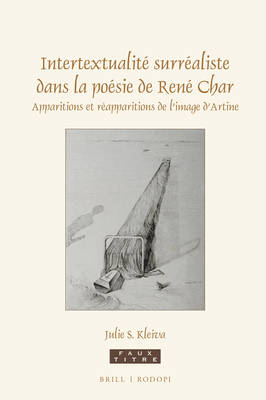
- Afhalen na 1 uur in een winkel met voorraad
- Gratis thuislevering in België vanaf € 30
- Ruim aanbod met 7 miljoen producten
- Afhalen na 1 uur in een winkel met voorraad
- Gratis thuislevering in België vanaf € 30
- Ruim aanbod met 7 miljoen producten
Zoeken
Intertextualité Surréaliste Dans La Poésie de René Char
Apparitions Et Réapparitions de l'Image d'Artine
Julie S Kleiva
€ 161,95
+ 323 punten
Omschrijving
Dans Intertextualité surréaliste dans la poésie de René Char, Julie S. Kleiva montre comment la figure d'Artine, initialement une représentante du surréalisme charienne, se transforme en une image complexe, polymorphe et considérablement présente à travers l'oeuvre de René Char (1907-1988). En adoptant une approche intertextuelle, Kleiva soutient que la figure d'Artine représente la force déroutante au coeur de l'imagination poétique charienne. L'image revenante d'Artine favorise l'idée d'une continuité dans l'oeuvre poétique de Char malgré la rupture articulée au milieu des années 30.
In Intertextualité surréaliste dans la poésie de René Char, Julie S. Kleiva demonstrates how the initially surrealist figure of Artine becomes a complex, polymorphus and, most importantly, significally present image throughout the work of the French poet René Char (1907-1988). By adopting an intertextual approach, Kleiva argues that the figure of Artine is a disturbing and confusing creative agency that corresponds to the core of Char's poetry. The reappearing image of Artine serves to demonstrate that Char's poetic rupture of the years from 1935-1937 has been exaggerated, and must be viewed as a development rather than a clean break.
In Intertextualité surréaliste dans la poésie de René Char, Julie S. Kleiva demonstrates how the initially surrealist figure of Artine becomes a complex, polymorphus and, most importantly, significally present image throughout the work of the French poet René Char (1907-1988). By adopting an intertextual approach, Kleiva argues that the figure of Artine is a disturbing and confusing creative agency that corresponds to the core of Char's poetry. The reappearing image of Artine serves to demonstrate that Char's poetic rupture of the years from 1935-1937 has been exaggerated, and must be viewed as a development rather than a clean break.
Specificaties
Betrokkenen
- Auteur(s):
- Uitgeverij:
Inhoud
- Aantal bladzijden:
- 172
- Taal:
- Frans
- Reeks:
- Reeksnummer:
- nr. 425
Eigenschappen
- Productcode (EAN):
- 9789004368774
- Verschijningsdatum:
- 30/08/2018
- Uitvoering:
- Hardcover
- Formaat:
- Genaaid
- Afmetingen:
- 160 mm x 236 mm
- Gewicht:
- 358 g

Alleen bij Standaard Boekhandel
+ 323 punten op je klantenkaart van Standaard Boekhandel
Beoordelingen
We publiceren alleen reviews die voldoen aan de voorwaarden voor reviews. Bekijk onze voorwaarden voor reviews.











